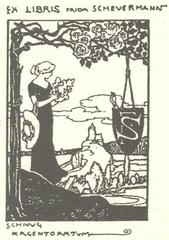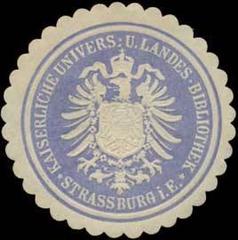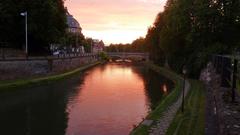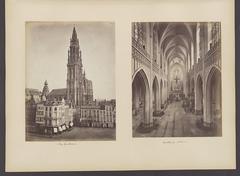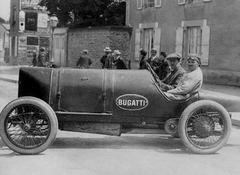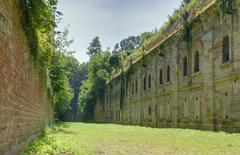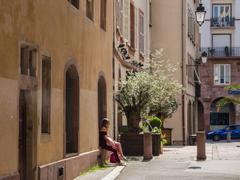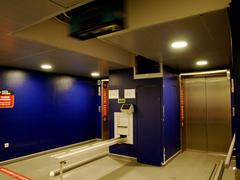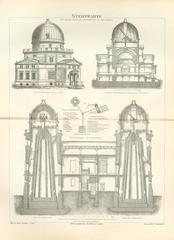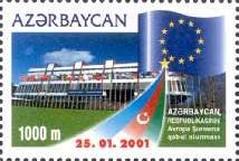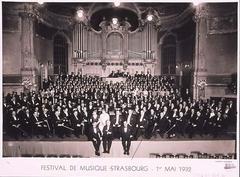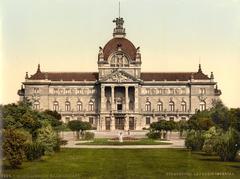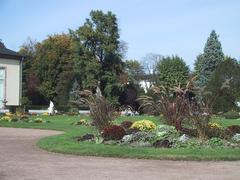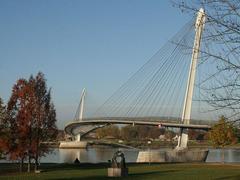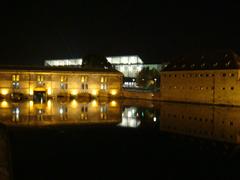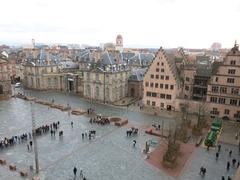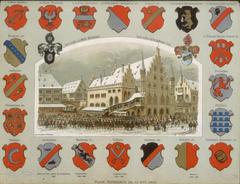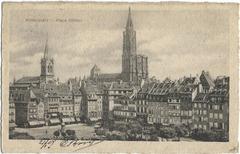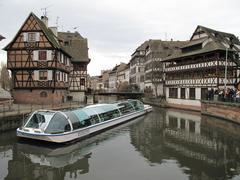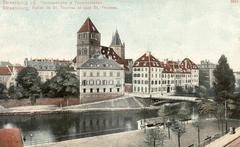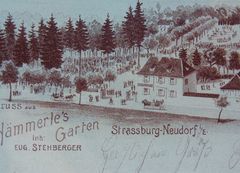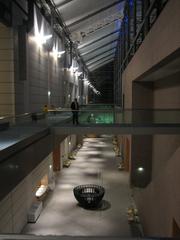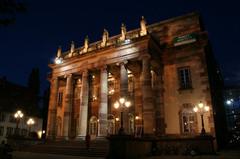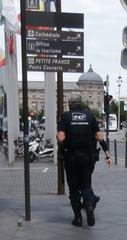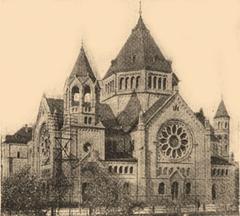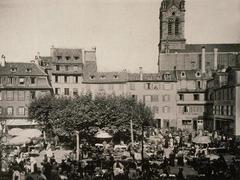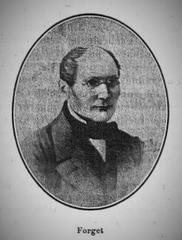
Rue Gutenberg Strasbourg: Visiting Hours, Tickets, and Historical Significance
Date: 04/07/2025
Introduction
Located in the heart of Strasbourg’s UNESCO-listed Grande Île, Rue Gutenberg is a vibrant testament to the city’s enduring cultural, intellectual, and architectural legacy. Named after Johannes Gutenberg—the revolutionary inventor of the movable-type printing press—the street and its surrounding squares invite visitors to walk in the footsteps of one of history’s greatest innovators. Rue Gutenberg and adjacent Place Gutenberg offer a blend of medieval and Renaissance architecture, lively markets, and a palpable sense of Strasbourg’s role as a crossroads of European thought and commerce. Whether you are a history buff, architecture enthusiast, or casual tourist, this comprehensive guide provides everything you need for a memorable visit: practical details, historical context, nearby attractions, and expert travel tips.
For official updates and planning resources, consult the Strasbourg Tourism website, Gutenberg Gesellschaft, and EnjoyStrasbourg.
Table of Contents
- Introduction
- Visiting Rue Gutenberg: Hours and Accessibility
- Historical Context and Significance
- Architectural and Urban Character
- Attractions, Events, and Local Life
- Getting There and Transport Options
- Dining, Shopping, and Accommodation
- Practical Visitor Tips
- Frequently Asked Questions (FAQ)
- Visual and Interactive Resources
- References and Further Reading
Visiting Rue Gutenberg: Hours and Accessibility
Rue Gutenberg and Place Gutenberg are public spaces, open 24 hours a day, year-round, and free to access. There are no tickets or admission fees required to stroll the street or enjoy its vibrant atmosphere. The area is mostly flat and paved, with accessibility features such as ramps and smooth walkways, though some sections have cobblestones that may be uneven for wheelchairs or strollers.
Best times to visit:
- Spring and Early Autumn: Pleasant weather and outdoor café culture.
- Saturdays: The weekly book market at Place Gutenberg.
- December: Strasbourg’s famed Christmas markets enliven the area with festive décor and events.
Nearby museums and cathedral:
- Strasbourg Cathedral, Palais Rohan, and museums have specific opening hours (typically 9:00 AM to 6:00 PM) and may require tickets. Check their official sites for details.
Historical Context and Significance
Medieval Origins and Urban Development
Rue Gutenberg and Place Gutenberg are rooted in Strasbourg’s medieval past. The area flourished as part of a Free Imperial City within the Holy Roman Empire from the 13th century, becoming a center of trade, governance, and cultural exchange (audiala.com; worldcityhistory.com).
The surrounding streets were once bustling with market squares, guild houses, and timber-framed residences, reflecting the prosperity and diversity of medieval urban life (frenchmoments.eu).
The Gutenberg Connection
Johannes Gutenberg lived and worked in Strasbourg during the 1430s and 1440s. It was here that he developed the technologies that would lead to the creation of the movable-type printing press—a breakthrough that revolutionized knowledge dissemination across Europe (gutenberg-gesellschaft.de; thestar.com.my).
Strasbourg quickly emerged as a leading European printing hub, attracting scholars, artists, and merchants. Today, the city celebrates this heritage through the weekly book market and the annual Printers’ Festival at Place Gutenberg (audiala.com).
Architectural and Urban Character
Rue Gutenberg and its surroundings showcase the layered history of Strasbourg:
- Medieval and Renaissance influences: Cobblestone streets, half-timbered houses, and winding passageways create a picturesque ambiance (urtrips.com).
- 18th-century reconstruction: Many buildings feature ornate facades and timber framing, restored after wartime damage in the 20th century (fr.wikipedia.org).
- Place Gutenberg centerpiece: The square is dominated by the bronze statue of Gutenberg by David d’Angers (1840), symbolizing the spread of knowledge (FranceRent).
The district’s urban fabric blends medieval street patterns with monumental civic and religious architecture, including the nearby Strasbourg Cathedral (My Weekend in Alsace).
Attractions, Events, and Local Life
Place Gutenberg
A central meeting point, Place Gutenberg hosts:
- The weekly book market (Saturdays)
- The annual Fête des Imprimeurs (Printers’ Festival), celebrating the city’s printing legacy with workshops and family events (thestar.com.my)
Strasbourg Cathedral
Just steps away, this Gothic masterpiece is one of Europe’s most iconic religious sites (thecrazytourist.com).
Museums and Cultural Institutions
Within easy walking distance:
- Musée Alsacien
- Historical Museum
- Palais Rohan (Museum of Fine Arts, Archaeology, Decorative Arts)
(dabblinginjetlag.com)
Gastronomy
The area abounds with Alsatian winstubs, contemporary cafés, patisseries, and ice cream shops. Regional specialties like tarte flambée, choucroute garnie, and kougelhopf are widely available (enjoystrasbourg.com).
Shopping
Independent boutiques, bookstores, and artisanal shops offer unique souvenirs such as local wines, chocolates, and handcrafted jewelry.
Getting There and Transport Options
- Tram: Langstross Grand’Rue (Lines A, D) and Homme de Fer stops are closest.
- Bus: Multiple lines serve the Grande Île perimeter.
- Train: Strasbourg’s main station is a 15-minute walk or short tram ride.
- Car: Parking garages (Gutenberg, Kléber) are nearby, but old town driving is restricted.
- Bike: Strasbourg features over 560 km of bike paths (enjoystrasbourg.com).
Dining, Shopping, and Accommodation
- Dining: From historic winstubs to trendy cafés, the area caters to all tastes. Make reservations for popular spots, especially on weekends (My Weekend in Alsace).
- Accommodation: Options range from boutique guesthouses to international hotels. Maison Rouge Strasbourg Hotel, just 200 meters from Place Gutenberg, is especially well-located (urtrips.com).
Practical Visitor Tips
- Footwear: Wear comfortable shoes due to cobblestones (dabblinginjetlag.com).
- Language: French is official, but English and German are widely understood.
- Museum Pass: Strasbourg Museum Pass or City Pass offers discounts and free entries (dabblinginjetlag.com).
- Safety: The area is safe, with public amenities like restrooms and benches.
- Photography: Early morning or late afternoon light is best for pictures.
Frequently Asked Questions (FAQ)
Q: What are the visiting hours for Rue Gutenberg?
A: Rue Gutenberg is open 24/7 year-round as a public thoroughfare.
Q: Is there an entry fee?
A: No, Rue Gutenberg and Place Gutenberg are free to access.
Q: Is Rue Gutenberg accessible for visitors with disabilities?
A: Yes, though some cobblestone sections may require caution. Most public amenities are accessible.
Q: Are guided tours available?
A: Yes, several walking tours include Rue Gutenberg. Booking in advance is recommended.
Q: What nearby attractions can I visit?
A: Strasbourg Cathedral, Palais Rohan, Petite France, Place Kléber, and multiple museums are within walking distance.
Visual and Interactive Resources
Explore virtual tours, interactive maps, and high-quality images on the official Strasbourg Tourism website and local guides. These resources help preview the district and plan your itinerary.
References and Further Reading
- audiala.com
- enjoystrasbourg.com
- FranceRent.com
- frenchmoments.eu
- My Weekend in Alsace
- thestar.com.my
- Wikipedia - History of Strasbourg
- urtrips.com
- worldcityhistory.com
- dabblinginjetlag.com
Plan Your Visit
Embrace the opportunity to experience Strasbourg’s layered history and vibrant culture along Rue Gutenberg. For personalized guides, travel updates, and exclusive content, download the Audiala app. Follow us on social media and consult our related articles for more in-depth insights on Strasbourg’s must-see attractions.

